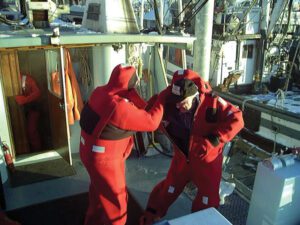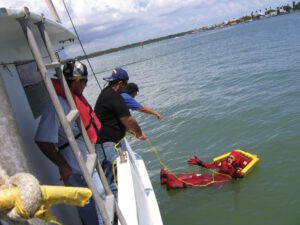
Because you never know how your day is going to end, emergency drills are required to be conducted monthly on many fishing vessels during the season. Even if they are not required on your vessel, drills are a standard in the industry. In the event of a casualty, not conducting drills is a poor defense.
Without regular drills, in an emergency the crew will be looking to the master to answer the big question: what do we do? Meanwhile, the master of the vessel is flooded with sensory information that is incomplete or unknown as well as dealing with conflicting emotions and the weight of responsibility for dealing with the emergency.
This is not the best state of mind for someone to make the correct decision. A crew that is not trained in what to do makes it even more difficult for the master to respond effectively to a life-threatening situation.
According to John Leach, PhD. a researcher on emergency response from Lancaster University, U.K., people in any life-threatening emergency act in several different but predictable ways. During the onset of an emergency, only about 12%-25% of victims remain calm, maintain awareness, assess, plan and take appropriate action. About 75% of people become stunned and bewildered, resulting in impaired reasoning, confusion, tunnel vision and in disbelief and denial of the situation.
The remaining slice shows inappropriate behavior or paralyzing anxiety. They freeze, or worse, panic.
When emergency duties are assigned to crew, safety orientations are given and emergency drills are practiced, people are more effective in dealing with the problem and they function at a more automatic level. Drills build teamwork and mutual trust. In other words, drills increase the percentage of people who respond effectively, and lowers the number of people who are unable to act.
There are 10 tasks that must be practiced in a drill from 46 CFR 28.270 regulations:
- Abandoning the vessel.
- Fighting a fire in different locations on the vessel.
- Recovering an individual from the water.
- Minimizing effects of flooding.
- Launching survival craft and recovering lifeboats and rescue boats.
- Donning immersion suits or other Personal Flotation Devices.
- Donning a fireman’s outfit and SCBA (if vessel is so equipped).
- Making a voice radio distress call and using visual distress signals.
- Activating the general alarm.
- Reporting inoperative alarm and fire detection systems.

The following four drill scenarios can cover all of the 10 tasks. Each scenario takes just 15 to 20 minutes. If you held one 15 minute scenario a week, you would complete all the essentials in a month. For instance:
Abandon vessel – covers drill areas 1, 5, 6, 8, 9, 10
Fighting fire – covers drill areas 2, 7, 8, 9, 10
Crew overboard – covers drill areas 3, 6, 8, 9, 10
Flooding – covers drill areas 4, 8, 9, 10.
Many of these areas need to be role played since you can’t practice a MAYDAY on a live radio or actually launch and inflate a raft. However, everyone on the vessel should be able to demonstrate how to find the proper radio, calling channel and find their position on a GPS/Plotter or chart.
A good pop quiz for all crew is use a dead microphone and ask for the top five most important things to state in a MAYDAY (make double sure the mic is actually dead!). All crew should be able to practice what is involved with releasing a raft from its cradle and how they would move it to an appropriate place to launch.
In addition, practice donning an immersion suit in 60 seconds, recovery of a crew overboard, how to plug and dewater the vessel, etc.
All crew members need to participate in the drill; the drill should be as hands on as possible. Afterward, the drill should be debriefed and emergency assignments might need to be changed for better efficiency. All drills should be logged and signed by crew who participated.
Drills should be an opportunity to break the monotony, have some fun, build confidence and trust in your crew and above all, allow you to respond more effectively if trouble does occur. Emergencies develop when you least expect it. But with safety orientations and practicing crew assignments, your chances of surviving to fish another day improve.
For those with iOS smart phones, you can download the app FVdrills for free. This will give you practical scenarios, tips on how to start a drill, debriefing points, as well as noting the time it takes to don suits. You can log drills and send shoreside for record keeping and keep track of your monthly EPIRB (Emergency Position Indicating Radio Beacon) testing as well.
No person may oversee the drill unless that person has been trained in the proper procedures for conducting the activity. A number of training organizations on the West Coast and Alaska offer Coast Guard-accepted drill conductor classes, including AMSEA.
Remember that in a life-threatening emergency if you don’t rise to the occasion, you fall to the level of your training.
The Alaska Marine Safety Education Association (AMSEA) has a mission is to reduce injury and death in the marine and freshwater environment through education and training provided by a network of marine safety instructors. The Sitka, Alaska-based organization has been offering marine safety training to commercial fishermen and thousands of other mariners since 1985.
More information on marine safety topics can be found at www.amsea.org
